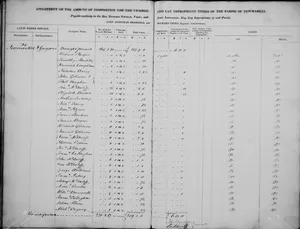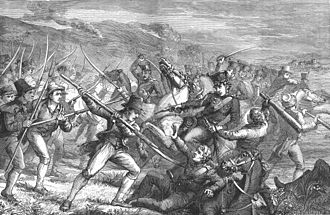The Tithe Applotment Books are a vital source for genealogical research for the pre-Famine period, given the loss of the 1821-51 Census records. The population of Ireland was recorded in 1841 as 8.2 million. It would have been somewhat less than this during the 1820s and 1830s, when the Tithe Applotment Books were compiled. Acts of Parliament of 1823 and 1832 provided for the conversion of tithes into a fixed charge on land and specified the average price of wheat or oats in the parish in the seven years before 1821 as the basis on which the tithes would be calculated. They also extended the application of tithes to pasture, where previously they had been levied only on tillage.[1] The books were compiled between 1823 and 1837 in order to determine the amount which occupiers of agricultural holdings over one acre should pay in tithes to the Anglican Church of Ireland (the main Protestant church and the church established by the State until it’s dis-establishment in 1871). The nature of the tax varied from region to region and, for a long time, livestock farmers were exempted from the levy.[2]
Research your ancestors on MyHeritage
Using the Tithe Applotment BooksUsing the Tithe Applotment Books
There is a manuscript book for almost every civil (Church of Ireland) parish in the country giving the names of occupiers of each townland, the amount of land held and the sums to be paid in tithes. Because the tithes were levied on agricultural land, most urban parishes are not included. Unfortunately, the books provide only the names of heads of family, not other family members. The parishes used in the Tithe Applotment Books are civil or Church of Ireland parishes, which often differ in name and territory from Catholic parishes.

While there was no standardised layout for the books in the same way that would be found in later records such as Griffiths Valuation, they do contain a lot of valuable information. The majority will at least indicate the landlord for that area, the occupants of each townland, the size of their holdings and how much rent they were paying, which included the tithe. Most of the books will also include the year they were compiled and, in some cases, there might be more than one book for a parish, compiled in different years. This can be useful for a comparison and tracking ancestors.
The Tithe Applotment Books were the first in a series of National Archives records of genealogical interest to be digitised by the Genealogical Society of Utah in partnership with the National Archives of Ireland and placed online free to access. Be aware however, when using the index available on the National Archives of Ireland, that there are a number of transcription errors with family names and placenames. Abbreviations of names were often used, for example ‘Thomas’ written as ‘Thos’ or 'James' as 'JS'. Even accurate transcriptions of place names can pose problems, because the spelling was not standardised until the 1837 Ordnance Survey of Ireland. The best approach is to browse the index and to check each individual images for the full details.
The Tithe Applotment Books for Northern Ireland are held in the Public Record Office of Northern Ireland, but there are microfilm copies in the National Archives of Ireland which can be consulted in their reading room.[3] They can also be accessed online through the RootsIreland website, which requires a subscription. They are available under the Census Substitutes section.[4]
Tithe DefaultersTithe Defaulters
All landholders had to pay tithes to the Church of Ireland as the Established Church, regardless of their religious denomination. Roman Catholic farmers were also required to pay a separate tithe to their own priests, as well as the Church of Ireland, and as a consequence deeply resented this official tax. A conflict, known as the Tithe War, broke out which led to the transfer of direct responsibility for the payment of tithes from tenants to landlords. The people most affected by this conflict were those who would be most affected by emigration and the famine in the next generation. Despite the name, the conflict mainly involved non-violent civil disobedience. However, there were incidents of violence, including several “battles” between farmers, clergy and police, resulting in many casualties including deaths. The ‘war’ began in Kilkenny in 1830 and included two notable atrocities, at Newtownbarry, Co. Wexford in June 1831 where yeomanry killed fourteen protestors and at Carrigshock, Co. Kilkenny in December 1831 where a process server and twelve policemen were killed.[5]

The Clergy Relief Fund was established in 1832 under the Recovery of Tithes (Ireland) Act, 1832 to assist Church of Ireland clergy affected by the non-payment of tithes.[6] The clergy made returns to government of the names of people who refused to pay tithes in order to receive compensation for unpaid tithes. This led to the creation of the Tithe Defaulter lists. The names in these records are of those who refused to pay the tithe and who were recorded by the Church of Ireland clergy. Information listed in these records may include the name, address, occupation of the defaulter, along with information regarding the relevant parish which often includes data from the 1831 and 1841 census for comparisons (number of houses recorded in census vs. number of tithe defaulters) and the text of the relevant clergy affidavit. Some of these returns survive in the form of schedules of recording. These include the names of approximately 29,000 tithe defaulters and form part of the archives of the Office of the Chief Secretary.[7] This is a unique record of these people at the time that the various Schedules were compiled, namely, in June, July and August of 1832. Since the 1831 census was almost completely destroyed in the 1922 Public Record Office Fire, this is a very important source for these areas. The original schedules of defaulters for 1831 are held in the National Archives but are available to consult on MyHeritage.[8]
See alsoSee also
Explore more about Tithe Applotment BooksExplore more about Tithe Applotment Books
- Tracing Your Irish Ancestry (Part 2) on the MyHeritage blog
- Search - The Tithe Applotment Books, 1823-37 at The National Archives of Ireland
- County Clare Tithe Applotment Books - Surname Index at Clare County Library
- Tithe Applotments at Monaghan County Council Library
References
- ↑ "The Tithe Applotment Books, 1823-37". titheapplotmentbooks.nationalarchives.ie. Retrieved 2024-09-21.
- ↑ Dungan, Myles (2024-05-19). "Land Is All That Matters – GLOSSARY OF TERMS L-Z". Myles Dungan. Retrieved 2024-09-21.
- ↑ "The Tithe Applotment Books, 1823-37". titheapplotmentbooks.nationalarchives.ie. Retrieved 2024-09-21.
- ↑ "Find your Irish Ancestors today – Irish Family History Online Records Search Facility – Find your Irish Ancestors today with the Irish Family History Foundation online research service". www.rootsireland.ie. Retrieved 2024-09-21.
- ↑ Dungan, Myles (2024-05-19). "Land Is All That Matters – GLOSSARY OF TERMS L-Z". Myles Dungan. Retrieved 2024-09-21.
- ↑ Maxwell, Nick (2013-02-13). "The Tithe War; reports by Church of Ireland clergymen to Dublin Castle". History Ireland. Retrieved 2024-09-21.
- ↑ "Tithe applotment records – The National Archives of Ireland". Retrieved 2024-09-21.
- ↑ "Ireland Tithe Defaulters, 1831". MyHeritage. Retrieved 2024-09-21.

